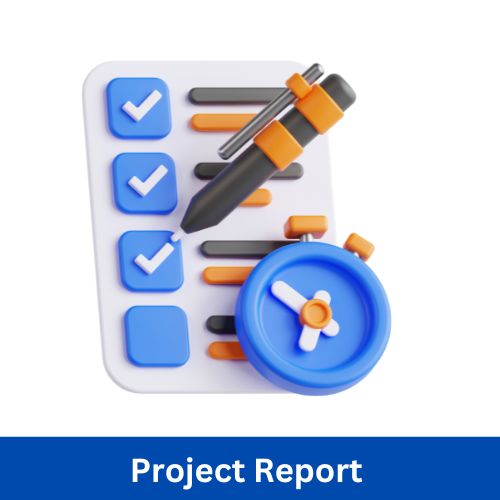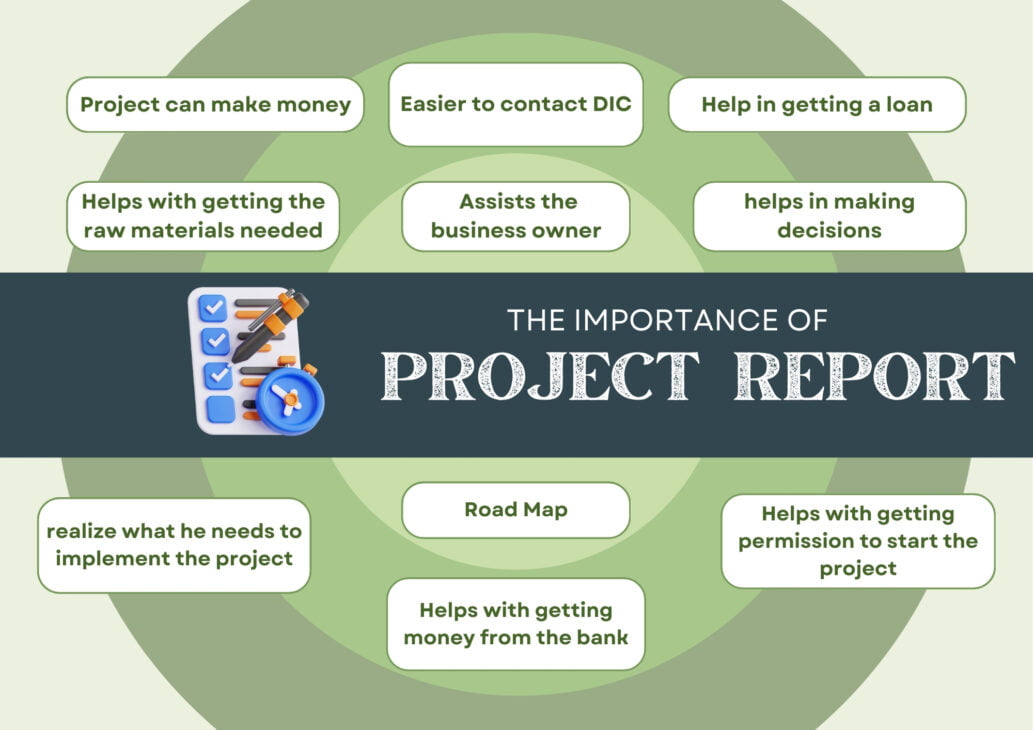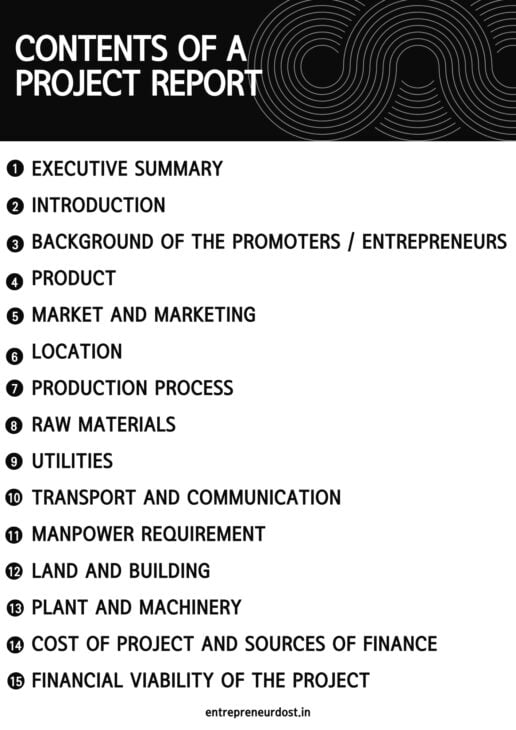Introduction
An entrepreneurship project report is a long paper that explains all the different parts of a business idea. It serves as a blueprint for entrepreneurs to plan, execute, and monitor their projects effectively. Once the feasibility study is finished, the business owner needs to get ready a project report. This report has all the details from the study to see if the business can work. It’s called a project report. In this article, I will share the Project Report Format, which you can download as a PDF file.
Meaning and Definition of Project Report

All the information collected during the feasibility studies will be combined into a single main report. It is called a project report or it is also called a feasibility report. A project report is a legal document where all the information that is included in technical analysis, financial analysis, profitability analysis, economic analysis, etc. are put together into one report. A project report may be defined as a document concerning any investment proposal based on certain information and factual data to appraise the project.
The project report has all the details about the project we want to do. It is performed as a blueprint of all operations to be undertaken to get the desired results. The project report is normally a business plan of action and mentions its goals and objectives. It turns the business idea into a profitable venture without any disorder or uncertainty.
It tells you everything you need to finish a project so you can organize it at the right time. Thus, a project report is a document that provides details on the overall picture of the proposed business. Simply, a project report is a paper that talks about an investment.
The project report tells us what the entrepreneur plans to do for their business and if it’s possible, makes money, and is good for the community. It is based on a project report that the bank or financial institution does an appraisal before granting a loan or financial assistance.
Other groups that help with things like workshops, supplies, and funding want to make sure the project is a good idea too. Organizations can evaluate the project using the project report. Thus, a project report is an essential document for procuring assistance from financial institutions and for fulfilling other formalities for the implementation of the project.
Purposes/Objectives of the Project Report

The main goal of a project report is to check if a project can make money and if its production, marketing, and other parts are good. The report is important because:
To serve as a business plan indicating the objectives or goals of the enterprise and showing how these objectives are going to be achieved
- To act as a guide showing the way for the business and how to achieve the goal
- To help the business owner figure out early on if the project is doable so they can decide on investing
- To help an entrepreneur know what they need ahead of time to start their project.
- To show a general idea of various resource requirements like raw materials, manpower, finance, infrastructure facilities, etc., and also the means of providing them.
- To enable an entrepreneur to make crucial decisions such as: how much to produce to break even, how to fix the repayment schedule etc.
- To get financial assistance from banks and financial institutions (project report helps the financial institutions to evaluate the desirability of giving financial assistance)
- To forecast the demand and supply position, competitors’ position in the market, etc. To plan the fulfillment of expected performance in various areas like technology, marketing, finance, personnel, production, etc.
- To enable the government authorities to provide subsidies, tax exemptions, incentives, concessions, government clearance from Pollution Control Boards
In short, the main purpose of the project report is to provide information that is required for the project appraisal.
Importance of Benefits or Uses of Project Report (or Functions)

An entrepreneur undertakes a project with a specific objective. To achieve the goal, he must make a plan first. A goal without a strategy is just a wish. Actually project report is a written plan of the project to be undertaken for the attainment of the objective.
The project report tells us what the entrepreneur plans to do for their business and if it’s possible, makes money, and is good for the community. It describes what business an entrepreneur will do, what he hopes to achieve in his business, and how he will achieve it. The project report enables an entrepreneur to know the inputs required and confirms that he is proceeding in the right direction.
The project report looks at whether the project is practical in terms of things like money, and technology, and whether people want it. It gives a basic idea of what resources are needed and how to get them. This is necessary to secure loans from banks, financial corporations, and other financial institutions. It is also required to get a factory shed and other facilities at concessional rates. It is an operating document.
The important uses of P.R. are summarised as follows:
- It shows if the project can make money.
- It makes it easier to contact District Industries Centres to get temporary or permanent registration.
- It also helps with getting permission to start the project and finding a place to do it.
- It also helps with getting the raw materials needed to make the project.
- It helps with getting money from the bank to start the project.
- It assists the business owner in determining if the project is both technologically and economically feasible.
- It will help in getting a loan from the bank or other financial institutions.
- It is like a road map.
- It can also help you get a loan from banks or other financial organizations.
- It enables an entrepreneur to realize what he needs to implement the project.
- It anticipates strengths, weaknesses, opportunities, and threats (problems) of starting a venture.
- It helps in making decisions such as how much to produce to achieve breakeven, how to fix the repayment schedule etc.
The project report enables an entrepreneur to interact with realities and makes him or her aware of what to expect in the future in actually implementing the project. It is a drill, and good training before jumping into a venture.
Contents of a Project Report

In the feasibility studies, the project report includes background info about the industry and the company. It gives a complete analysis of the inputs and outputs of the project.
A project report generally contains the following information in a detailed and systematic manner (here summary only):
- Executive Summary: Here’s a quick overview of the whole plan. This highlights all important aspects of the plan concisely and appealingly. It contains basic information such as the name of the enterprise and its location, nature of business, type of product or service, and financial requirements.
- Introduction: General information regarding the company and product description.
- Background of the promoters / Entrepreneurs: Entrepreneur’s personal information – name, address, age, family background, educational qualification, work experience, project-related experience, investment potential, etc.
- Product: Details of products to be produced, details of the application of the product, product idea, proposed product mix, product standard, etc.
- Market and marketing: Market potential analysis, and-users of product, major buyers, area to be covered (local, regional, national, international), estimated selling price of the product, distribution channels to be adopted, trade practices, sales promotion devices, proposed market research, trade practice and trade channels adopted by the competitors, demand analysis
- Location: The specific place where the project will be located, different options that have been looked at, how we decided on the location, and the benefits of the chosen location.
- Production process: Manufacturing process, details of technology, process flow chart, production program, project network, etc.,
- Raw material: List of raw materials required in terms of quantity and quality, sources of requirement, cost of raw material, etc.
- Utilities: Water, power, steam sources, and costs; effluent disposal, etc.
- Transport and communication: Method, possibility of getting and costs of transport
- Manpower requirement: Requirement of skilled, semi-skilled personnel, technical and non-technical personnel, administrative/ managerial staff, and marketing personnel- sources of procurement, cost of procurement, etc., capacity; suppliers cost, alternatives available, cost of miscellaneous assets.
- Land and Building: The size of the land, the size of the building, how much it costs to build, the specific design, and the arrangement of the plants with their costs.
- Plant and Machinery: Details of machinery and equipment required.
- Cost of project and sources of finance: Splitting up the project expenses into fixed assets (like land, building, machinery, furniture), money needed for day-to-day operations (working capital), initial expenses, unexpected costs, and ways to cover the project’s expenses (like selling shares, taking loans).
- Financial viability of the project: Cost of production and profitability for the first years, break-even analysis; analysis of cash flow, and fund flow statements.
Project Report Format
I have provided the detailed format of the project report in a PDF document for your convenience. You can access it by clicking the button below.
Requirements of a Good or an Ideal Project Report
An ideal project report should include the following key elements:
- You need to work with a team of experts to make the project report.
- The project report should be based on a proper survey and systematic preliminary study of the project.
- The project report is just a tool, not the final goal.
- To create the project report, you should get assistance from a team of experts.
- Thorough discussions must be made with experts, and various personnel of concerned departments before finalizing the report.
- The result should be to receive finance and to get the project implemented.
- Complete satisfaction of the entrepreneur/promoter should be ensured before the report is submitted to the financial institutions.
- Remember, the project report needs to be concise, correct, and detailed.
- The contents of the project report should be in a logical sequence.
Conclusion
A project report is a business plan. It outlines a project’s goals, methods, and financial projections. It’s crucial for getting funding and making smart decisions. It serves as a comprehensive roadmap, guiding entrepreneurs from conceptualization to execution and beyond. By providing a detailed analysis of market potential, financial projections, and operational strategies, a project report empowers decision-making, attracts investors, and secures necessary resources.
Remember, a project report is more than just a document; it’s a persuasive tool that can transform an idea into a thriving venture.











Leave a Review